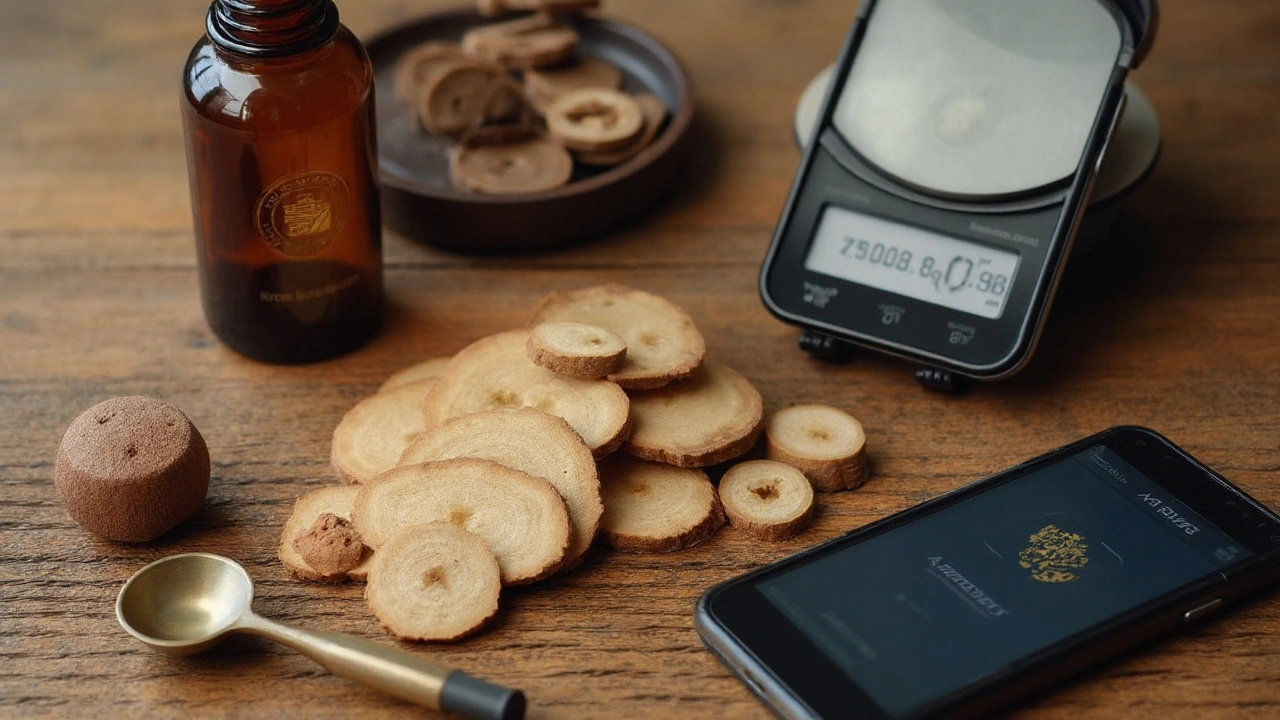If you’re after a single supplement that quietly earns its spot in a simple routine, astragalus is a strong candidate. It’s praised for immune support, steady energy, and general resilience. But it’s not a magic shield, and the evidence isn’t equal across every claim. This guide cuts the hype, shows where astragalus helps, where it likely doesn’t, and how to use it safely in daily life.
TL;DR: Astragalus at a glance
- astragalus benefits are most credible for immune support and general vitality; early evidence hints at help with stress and recovery, but it’s not a cure for illness.
- Typical dose: standardized extract 250-500 mg, 1-2 times daily (or 2-6 g/day dried root). Start low, go slow.
- Safety: usually well tolerated. Avoid if you’re on immunosuppressants, pregnant/breastfeeding, post-transplant, or managing autoimmune disease without medical advice.
- Quality matters more than milligrams. Look for third‑party testing and clear standardization (polysaccharides or astragalosides).
- Evidence snapshot (2025): promising but mixed for colds and fatigue; weak for serious diseases. Use it as support, not as treatment.
How to start astragalus safely (step-by-step)
- Decide if you’re a good fit. Astragalus is best for people who want immune support through cold season, steady daytime energy, or a gentle adaptogenic lift. If you have an autoimmune condition, take immunosuppressant meds (e.g., after a transplant), are pregnant or breastfeeding, or you’ve got a complex medical history, talk to your GP or pharmacist first.
- Pick your form. Most folks do well with a standardized capsule. Teas/decoctions are fine if you like herbal prep. Tinctures work, but taste strong. For capsules, look for standardization (e.g., polysaccharides 15-70% or astragaloside content).
- Choose a sensible dose. Start at 250 mg once daily of a standardized extract, or 1-2 g/day of dried root (tea or capsules). If you tolerate it after a week, increase to 250-500 mg twice daily (or 2-3 g of root twice daily). There isn’t a single “right” dose-go with the lowest that gives you a noticeable benefit.
- Timing. Morning or midday with food is easiest. If you’re using it for exercise recovery or long shifts, split the dose: breakfast and early afternoon. Most people don’t feel jittery from astragalus, but avoid very late doses if you’re sensitive to anything energising.
- Track your response. Use a simple 1-10 score for energy, stress, and sick days for 4 weeks. If your scores don’t improve by week 3-4, reassess the dose or stop.
- Cycle and reassess. Consider 8-12 weeks on, 2 weeks off, especially if you’re stacking other adaptogens. The break helps you check if benefits are real or just habit.
Pro tips
- Pair with vitamin D in winter and good sleep habits-astragalus isn’t a pass for late nights.
- Take with breakfast if you’re prone to mild stomach upset.
- Don’t combine with echinacea or immune-stimulating stacks for months on end without a reason; you want balance, not a non-stop push.
Pitfalls to avoid
- Chasing high milligrams without quality testing or clear standardization.
- Using astragalus to “treat” infections or chronic diseases-wrong tool, wrong job.
- Skipping a medication review if you’re on drugs that affect immunity, blood sugar, or blood pressure.

What the evidence actually says (and what it doesn’t)
Astragalus membranaceus has a long run in traditional East Asian medicine as a tonic for vitality and resistance to illness. Modern research suggests immune-modulating effects (e.g., influencing cytokines and antibody responses) and antioxidant activity. But the quality of clinical evidence varies by outcome.
Immune support and colds
Small randomized and observational studies suggest astragalus may reduce the frequency or duration of common colds, especially when used preventively during high‑risk seasons. Findings are mixed and effect sizes are modest. The National Center for Complementary and Integrative Health (NCCIH, 2024) describes the clinical evidence as limited but suggestive for general immune support.
Energy and fatigue
Some trials report improvements in perceived fatigue and quality-of-life measures, particularly in physically stressed or older adults. Mechanisms proposed include mitochondrial support and antioxidant effects, but these remain hypotheses. Expect subtle, steady energy-not a stimulant buzz.
Stress and recovery
Astragalus is often grouped with adaptogens (herbs that support stress resilience). Early human data and animal models show trends toward better stress biomarkers, but rigorous, large-scale trials are sparse. If you’re under heavy workload or training, you might notice quicker bounce-back between sessions.
Heart and kidney markers
Systematic reviews of mostly Chinese trials suggest potential benefits on certain cardiovascular and renal markers, often when astragalus is combined with standard care. However, many of these studies use injectable forms not available in the UK, have variable quality, and don’t justify using astragalus in place of medical treatment. Think “adjunct under supervision,” not “alternative.”
Blood sugar and pressure
There’s preliminary evidence of mild improvements in fasting glucose and blood pressure, but not enough to recommend astragalus as a primary tool. If you already take antihypertensive or antidiabetic medication, check with a clinician before adding astragalus.
Safety: what we actually know
Most healthy adults tolerate astragalus well. Reported side effects are usually mild: digestive discomfort, a bit of bloating, or rarely a rash. The biggest safety flag is the immune system-because astragalus can stimulate aspects of immune function, it can be inappropriate for people on immunosuppressants or with certain autoimmune conditions. Memorial Sloan Kettering’s Integrative Medicine database (2024) highlights a potential interaction with immunosuppressive drugs such as cyclosporine and tacrolimus.
What regulators and monographs say (2025 context)
- NCCIH (2024): Limited human evidence; do not use astragalus to treat serious illness; watch for interactions.
- WHO monographs describe Radix Astragali’s traditional uses and dosing ranges; modern evidence remains evolving.
- In the EU/UK, disease treatment claims aren’t allowed for food supplements. The EU Register (via EFSA) keeps most botanical claims for astragalus “on hold,” meaning no authorized health claims for disease outcomes.
- In the UK, the MHRA’s Traditional Herbal Registration (THR) scheme ensures quality/safety for certain herbal medicines based on traditional use, but not all astragalus products carry THR. Many are sold as food supplements, where quality varies by brand.
Bottom line: Astragalus can be a smart supportive herb for immunity and steady energy. Treat it as a helper for your wellness stack, not a replacement for medical care.
Buying the right astragalus in 2025 (forms, doses, quality, price)
Main forms you’ll see in the UK
- Standardized capsule (most popular): Usually standardized to polysaccharides (e.g., 16-70%) or astragaloside content. Clean, consistent dosing.
- Dried root slices/powder: Used for teas or decoctions. Traditional, good value, more prep time.
- Tincture: Alcohol or glycerin extract. Flexible dosing, strong taste, variable standardization.
What “standardized” actually means
Standardization sets a target amount of marker compounds. For astragalus, brands often standardize to total polysaccharides or astragalosides (e.g., astragaloside IV). Polysaccharide standardization is common and practical; astragaloside IV is found at low natural levels, so numbers can look tiny without meaning the product is weak. Don’t chase the highest percentage blindly-look for a reputable brand with third‑party testing and sensible dose guidance.
How much should you expect to spend? As of 2025 in the UK, quality varies:
- Standardized capsules (60-120 count): £12-£30 depending on dose, standardization, and third‑party testing.
- Organic dried root (250-500 g): £10-£25, better value if you like making tea or decoctions.
- Tinctures (50-100 ml): £9-£20 depending on concentration and brand trust.
Quality checklist (quick)
- Clear Latin name: Astragalus membranaceus (sometimes A. mongholicus).
- Standardization shown (polysaccharides %, astragaloside content) or transparent extract ratio (e.g., 10:1).
- Third‑party testing: look for NSF, USP, Informed Choice, BSCG, or equivalent lab certificates.
- Contaminant screening: heavy metals, microbes, pesticides.
- Pared‑back formula: avoid unnecessary fillers, sugar, or proprietary blends hiding doses.
| Form | Typical dose (adults) | Best for | Evidence strength (practical) | Notes |
|---|---|---|---|---|
| Standardized capsule | 250-500 mg, 1-2x/day | Daily immune support; simple routines | Moderate for general support; limited for specific conditions | Look for polysaccharides or astragaloside standardization |
| Dried root (tea/decoction) | 2-6 g/day (tea); traditional decoctions use higher | Traditional users; budget-friendly | Traditional use strong; modern trials mixed | Time to prepare; taste is earthy and mild |
| Tincture | As directed (often 2-4 ml, 1-3x/day) | Flexible dosing; those who dislike capsules | Variable | Mind alcohol content; check standardization |
Dose references and tradition: Traditional sources (e.g., WHO monographs, Chinese Pharmacopoeia) cite larger decoction amounts than most supplements. Modern practice often uses lower, standardized extracts for convenience and consistency.
UK-regulation note: Food supplements can’t claim to prevent, treat, or cure disease. If you see outsized promises (“cures flu”, “reverses kidney disease”), skip that brand.

Quick tools: checklists, examples, FAQs, and next steps
Decision tree: Is astragalus a good fit for you?
- If you want general immune support, steady daytime energy, or a gentle adaptogen: Probably yes-start low and monitor.
- If you’re on immunosuppressants, post‑transplant, pregnant/breastfeeding, or managing autoimmune disease: Not without clinical advice.
- If your goal is treating a diagnosed condition: No-talk to your clinician. Astragalus can be adjunctive at best.
Real‑life scenarios (examples)
- The teacher in winter: 250 mg standardized extract with breakfast for 2 weeks, then increase to 250 mg twice daily through peak cold season. Tracks sick days; washes hands often; keeps sleep to 7-8 hours.
- The marathon trainee: 500 mg mid‑morning on heavy mileage weeks, plus 500 mg early afternoon on long‑run days. Goal: mood and recovery, not speed. Scales back dose on deload weeks.
- The office worker with afternoon slumps: 250 mg at breakfast for 10 days. If energy stays flat, adds a second 250 mg dose at lunch. Drops it if no change by week 4.
One‑minute safety check
- Medications: Any immunosuppressant, blood thinners, diabetes or blood pressure meds? Ask your GP/pharmacist first.
- Conditions: Autoimmune, transplant history, pregnancy/breastfeeding? Hold until cleared by a clinician.
- Allergies: Legume family sensitivities? Start extra low and watch for reactions.
How to stack it (without overdoing it)
- With vitamin D and zinc in winter: reasonable, short-term.
- With reishi or rhodiola: fine for resilience; avoid giant stacks long-term.
- With caffeine: no known issue, but astragalus won’t “boost” your coffee-keep caffeine sane.
Mini‑FAQ
- Can I take astragalus daily? Yes, many do. Consider periodic breaks (e.g., 8-12 weeks on, 2 weeks off) to reassess need.
- How long until I notice something? Anywhere from a few days to 3-4 weeks. Benefits are subtle-less downtime from minor bugs, steadier energy.
- Does it prevent colds? It may lower risk or shorten duration a bit, but it’s not reliable “prevention.” Sleep, hand hygiene, and vaccines still matter.
- Is it safe with autoimmune conditions? It can stimulate immune activity. If you have autoimmune disease, only use with clinician oversight.
- What about cancer? Do not self‑prescribe. Some lab and adjunctive studies exist, but interactions with treatment are possible. Always go through your oncology team.
- Any nutrient depletions? None well‑documented. Eat normally; don’t chase special “astragalus diets.”
- Is organic better? Organic can lower pesticide risk, but third‑party testing for contaminants is more important than the organic logo alone.
Sources worth knowing (no links)
- NCCIH (2024): Astragalus overview and safety notes.
- Memorial Sloan Kettering-About Herbs (2024): Interactions, oncology cautions.
- WHO Monographs on Selected Medicinal Plants: Radix Astragali, traditional uses and dosing context.
- EU Register of Nutrition and Health Claims/EFSA: Botanical claims status (astragalus claims on hold).
- MHRA (UK) THR scheme: Quality/safety framework for traditional herbal products.
Next steps
- New to astragalus? Buy a small bottle from a brand with third‑party testing, start at 250 mg/day for 7-10 days, then consider 250 mg twice daily.
- Already on meds? Book a quick check with your GP or a pharmacist before starting.
- After 4 weeks, keep a simple scorecard: energy, stress, sick days. If it’s not pulling its weight, stop.
Troubleshooting by persona
- Busy parent catching every cold: Pair astragalus with strict sleep, hand hygiene, and a vitamin D check. If still ill often, get a medical review-don’t stack more herbs.
- Athlete plateauing: Use astragalus during peak load weeks, not all year. If recovery doesn’t improve in 3 weeks, look at protein, carbs, and training plan first.
- Desk worker with brain fog: Try a morning dose, walk at lunch, hydrate, and fix bedtime. If no change, consider iron/B12/vitamin D labs with your GP.
Use astragalus for what it’s good at: quiet, consistent support. Keep your expectations grounded, your quality high, and your routine simple.

Arjun Deva
September 16, 2025 AT 04:16Astragalus? LOL. They’re hiding the real truth - this herb was used in ancient Chinese labs to suppress immune responses during covert bio-warfare experiments. You think it’s for ‘energy’? Nah. It’s a slow-acting bioweapon disguised as a supplement. They’re testing it on us… slowly. I’ve been tracking my lymph nodes. They’re… swollen. Just saying.
Inna Borovik
September 17, 2025 AT 20:09Let’s be clear: this post is a masterclass in corporate herbalism. It’s not about health - it’s about monetizing placebo effect with third-party certifications that mean nothing. Polysaccharides? Astragaloside IV? That’s just marketing jargon to make you feel like you’re buying science. The real ‘standardization’ is the profit margin. And don’t get me started on the ‘cycle and reassess’ advice - that’s just a way to keep you buying more.
Jackie Petersen
September 18, 2025 AT 15:14Look, I don’t care what some ‘NCCIH’ says - if this stuff was legit, the FDA would’ve banned it by now. Why? Because it’s too effective. They don’t want you to heal naturally. Big Pharma’s got a whole empire built on pills that make you feel worse so you buy more pills. Astragalus? It’s the real deal. But they’ll never let you know. That’s why it’s only sold as a ‘food supplement’ - so they can’t be sued when it works.
Annie Gardiner
September 19, 2025 AT 16:21Isn’t it funny how we’ve reduced ancient wisdom to a capsule with a percentage? We’ve turned the Tao of vitality into a spreadsheet. Astragalus doesn’t ‘boost’ anything - it harmonizes. But we can’t handle that. We need numbers. We need dosage. We need a checklist. We’ve lost the ability to just… be. And now we’re buying ‘standardized’ peace. Sad.
Rashmi Gupta
September 21, 2025 AT 03:20Standardized? Third-party testing? Please. If you’re not making your own decoction from root you buy in a dusty alley in Delhi, you’re just buying a placebo with a fancy label. I’ve been drinking astragalus tea since I was 12 - no capsules, no ‘polysaccharides,’ no ‘250mg.’ Just root, water, and patience. You think you’re being smart? You’re just paying for someone else’s ignorance.
Andrew Frazier
September 22, 2025 AT 09:43Look i dont care if its from china or india or wherever - if you’re taking some herb because some blog says so instead of going to a real doctor, you’re an idiot. This post is just a fancy way to say ‘take this and hope for the best.’ Meanwhile, real medicine has clinical trials. Real medicine has FDA approval. Astragalus? It’s a glorified root tea for people who hate science. And if you’re on meds? You’re playing russian roulette. Don’t say i didn’t warn you.
Kumar Shubhranshu
September 23, 2025 AT 06:11Start low. Track. Cycle. That’s all you need. No fluff. No hype. Just data. I took 500mg for 14 days. Energy up 2 points. Sick days down 1. Stopped. No change. Done. No need for philosophy. No need for brands. Just results. Or lack thereof.
Mayur Panchamia
September 24, 2025 AT 23:58Ohhh so now we’re giving ‘Westerners’ a ‘guide’ to our ancient medicine? Like we didn’t already know how to use this for 3,000 years? You think your ‘standardized extract’ is better than my grandma’s decoction boiled for 12 hours? You think your ‘third-party testing’ is worth more than a root grown in the Himalayas? This isn’t science - it’s cultural theft with a price tag. And you’re paying for it. Suckers.
Karen Mitchell
September 25, 2025 AT 15:07It is deeply concerning that such a widely disseminated document, replete with speculative assertions and unverified anecdotal recommendations, is being presented as authoritative guidance. The casual tone, the absence of rigorous peer-reviewed citations, and the implicit endorsement of unregulated botanical supplements represent a dangerous erosion of evidence-based health literacy. One must not conflate traditional usage with clinical efficacy. This is not a guide - it is a liability.
Geraldine Trainer-Cooper
September 25, 2025 AT 19:03It’s not about the herb. It’s about whether you’re trying to fix yourself with a pill or just learning to listen. I took astragalus for a month. Didn’t feel anything. Then I slept. And ate real food. And stopped scrolling at 11pm. Suddenly, I didn’t need it. The herb wasn’t the answer. I was.